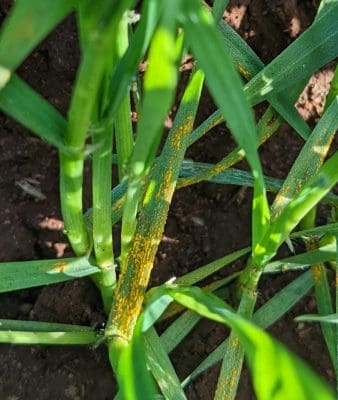
There has been an increase in stripe rust infections across the north, which hasn’t surprised experts due to conducive conditions. Photo: GRDC
EXPERTS are not surprised by increasing stripe rust reports in the northern grain growing region in recent weeks, with ongoing rain and the survival of a significant green bridge over summer generating conducive conditions for the disease to thrive.
New South Wales Department of Primary Industries (NSWDPI) senior plant pathologist, Steven Simpfendorfer provided an update on cereal diseases at the Grains Research and Development Corporation’s (GRDC) Grains Research Updates last week.
Dr Simpfendorfer said across both NSW and Queensland, growers have been noticing high stripe rust occurrences in emerging crops, even reporting cases of low levels in resistant-moderately resistant (RMR) varieties like Lancer.
“We’re seeing an early epidemic this season – growers wouldn’t usually be reporting infections this early on but the significant green bridge they experienced over summer has supported earlier inoculum development,” Dr Simpfendorfer said.
“This has meant there’s significantly more seedling infections this year, including in RMR varieties, but growers who selected more resistant varieties to help manage the disease shouldn’t be too alarmed.
“Growers should be proactive and consider applying an early fungicide to manage seedling infections in later sown wheat crops as all varieties are susceptible at this stage, but once resistant varieties establish more and their adult plant resistance genetics kick in, they’ll start to look after themselves.”
Dr Simpfendorfer said growers should be out in their paddocks assessing crops closely and making informed fungicide decisions to help manage the disease while crops are most vulnerable at early growth stages.
Globally, it is estimated that over five million tonnes of wheat are lost each year to stripe rust alone.
Stripe rust trials
This season, Grain Orana Alliance (GOA) are conducting trials to determine if they can serve as an early warning system for growers to help them indicate dominant stripe rust pathotypes in different cropping areas.

It is estimated that over 5Mt of wheat are lost each year globally to stripe rust Photo: Grain Orana Alliance
GOA chief executive officer, Maurie Street said rusts are highly mobile wind-borne pathogens and move readily across the landscape.
He said, because stripe rust has several pathotypes which can impact varieties differently, growers could be caught off guard by disease infection; for example, a wheat variety resistant to pathotype 198 could be highly susceptible to pathotype 239.
Mr Street said the GOA trials will assess a range of pure seed lines with known reactions to different pathotypes of stripe rust.
“The trials will be monitored regularly and if stripe rust occurs, we’ll be able to make an informed opinion on what pathotype is likely present, but we will also send samples away to the University of Sydney to confirm the pathotype,” Mr Street said.
“This information will help growers understand which other varieties may be at immediate risk of infection in an area, giving them a head start to implement a management strategy.”
Mr Street said these trials were developed in response to feedback from growers who were concerned about the turnaround between sending crop samples away to finding out what pathotypes were impacting their crops.
“We thought about how we could address the problem and generate an early warning system to help growers respond to the threat of stripe rust in conducive conditions.”
The trial sites are located in Coolah, Tottenham, Wongarbon, Gilgandra, and Coonamble, all in central NSW.
GRDC grower relations manager – north, Vicki Green said stripe rust is a huge concern for growers this season, so extending updated research and resources to help them mitigate risk has been a high priority for the organisation.
“We invest heavily in disease management at GRDC and this season, we’ve tried to make updated information as accessible as possible to growers,” Ms Green said.
“It’s great to see our industry partners respond to grower feedback and generate avenues to help them manage disease risk during the growing season and make more informed management decisions when it comes to varietal selection.”
Source: GRDC



HAVE YOUR SAY